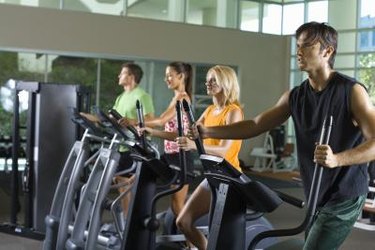
The term "elliptical" may refer to three different cardio machines. An elliptical trainer, elliptical glider and elliptical cross trainer are all sometimes lumped together as ellipticals. The elliptical cross trainer has one major difference that sets it apart with one glance: arm handles that move. There are other differences between the machines, as well, that may make one of these machines more enticing to you.
Design Differences
Video of the Day
An elliptical cross trainer has arms that move but the incline of the leg pedals is not adjustable. The moving arms allow you to tone your upper body by pushing and pulling the arms while pedaling. Controlling the incline, however, lets you choose to emphasize the hamstrings and glutes more. If you want to increase your intensity while exercising, you can increase your speed or resistance level from the pedals on all the machines, but the cross-trainer increases intensity in the arms, too. Raise the incline to increase intensity on the elliptical glider and elliptical trainer. Because there are options to control your intensity with each of the machines, you cannot truly say that one burns more calories than the other. On average though, ShapeFit.com says that a 145 lb. person can burn 300 calories in 30 minutes on an elliptical.
Video of the Day
Differences in Muscles Used
The cross trainer will use muscles in the upper body that the elliptical trainer or glider will not. All three machines require hip and knee extension from using the pedals. Hip extension happens courtesy of the thigh and buttocks muscles, including the gluteus maximus, biceps femoris, semitendiunosus, semimembranosus and adductor magnus. The quads are responsible for knee extension. These muscles work with all three machines, but the body must also perform shoulder flexion and extension, elbow flexion and extension, and protraction and retraction of the shoulder blades to move the arms. This is going to involve the back, shoulder, chest and forearm and upper arm muscles including the traps, rhomboids, lats, pecs, serratus anterior, levator scapulae, biceps, brachialis, brachioradialis, triceps, anconeus, teres major and coracobrachialis. None of those upper body muscles work when using an elliptical trainer or glider.
Difficulty of Use
When used as intended, the elliptical cross trainer will be more challenging to your balance and coordination than elliptical trainers or gliders. The challenge to your balance occurs because there is no point of contact between your body and the machine that does not move. You can hold onto the stationary handlebars of a cross trainer to get around this, but that defeats the purpose of using a cross trainer instead of an elliptical glider or elliptical trainer. The coordination is harder because as your right arm goes forward your right foot goes backwards, and the left side of your body is doing the opposite motions. Older adults and people living with disabilities may find elliptical gliders and trainers easier to use because of the handlebars that do not move; but if you want to improve your balance and coordination try the elliptical cross trainer.